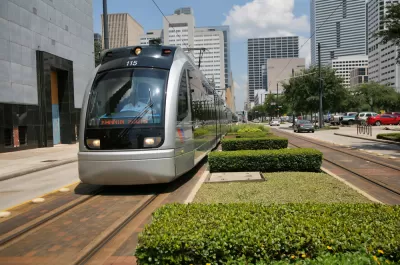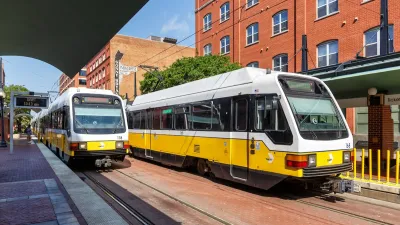Finally, the city seems to be reaping benefits from a major investment in public transportation.

Light rail has been an important (and expensive) part of urban development in both Dallas and Houston, two cities better known for sprawl than vibrant density.
In Houston, at least, two recent studies show that rail was a sound investment, notes Dian Nostikasari at Rice University’s The Urban Edge.
The first, from Texas Southern University, concluded, “[T[here have been measurable positive impacts from the development of light rail, at least on the Main Street corridor.”
The second, from one researcher with the Washington State Department of Transportation and another from the Texas A&M Transportation Institute, “examined changing land use within approximately half-mile of the rail stations along the original red, purple and green line in Houston.”
“That study found that along the original red line, there was a rise in commercial development that happened after the light rail came in but that began even before the red line was constructed. The study also found, increased development on vacant lands along these rail lines. This is a good thing as vacant land in cities like Houston tends to represent a lack of investment. Even as the Houston region continued to face a shortage of affordable housing supply, residential units along these rail lines increased – a trend across the country as living close to transit becomes a more attractive option.”
After many years of resistance to investing in public transit, light rail in Houston has been well received, as has the city’s investment in the bus system; together they represent a cultural and bureaucratic shift towards “walkable urbanism” in the city that doesn’t zone.
“Houston continues to grow but is at a crossroads post-Harvey,” Nostikarari writes. “Can it afford to continue growing as before and face the long-term consequences of being a car-dependent, outward growing metropolis? Or must it begin to think about prioritizing growing inward by improving its public transportation infrastructure and putting work places and other important destinations close to where people live while ensuring residents
FULL STORY: HOUSTON STUDIES SHOW LIGHT RAIL DID BRING SOME BENEFITS

Planetizen Federal Action Tracker
A weekly monitor of how Trump’s orders and actions are impacting planners and planning in America.

Maui's Vacation Rental Debate Turns Ugly
Verbal attacks, misinformation campaigns and fistfights plague a high-stakes debate to convert thousands of vacation rentals into long-term housing.

San Francisco Suspends Traffic Calming Amidst Record Deaths
Citing “a challenging fiscal landscape,” the city will cease the program on the heels of 42 traffic deaths, including 24 pedestrians.

Amtrak Rolls Out New Orleans to Alabama “Mardi Gras” Train
The new service will operate morning and evening departures between Mobile and New Orleans.

The Subversive Car-Free Guide to Trump's Great American Road Trip
Car-free ways to access Chicagoland’s best tourist attractions.

San Antonio and Austin are Fusing Into one Massive Megaregion
The region spanning the two central Texas cities is growing fast, posing challenges for local infrastructure and water supplies.
Urban Design for Planners 1: Software Tools
This six-course series explores essential urban design concepts using open source software and equips planners with the tools they need to participate fully in the urban design process.
Planning for Universal Design
Learn the tools for implementing Universal Design in planning regulations.
Heyer Gruel & Associates PA
JM Goldson LLC
Custer County Colorado
City of Camden Redevelopment Agency
City of Astoria
Transportation Research & Education Center (TREC) at Portland State University
Jefferson Parish Government
Camden Redevelopment Agency
City of Claremont





























